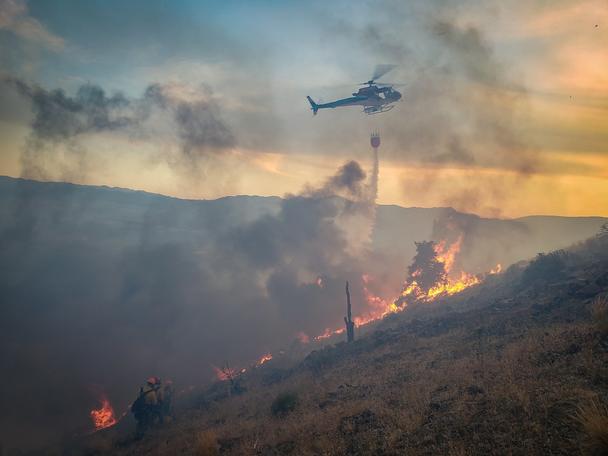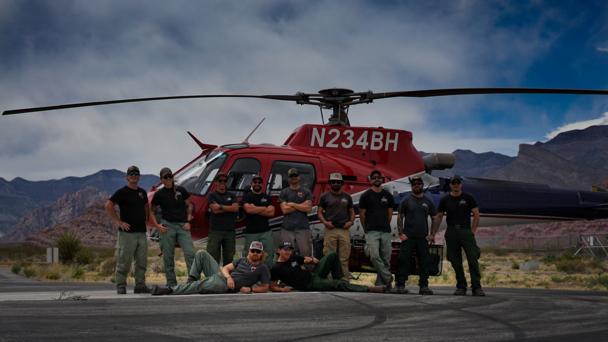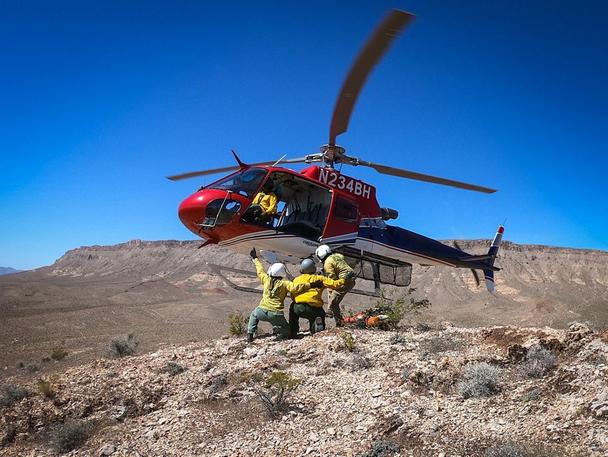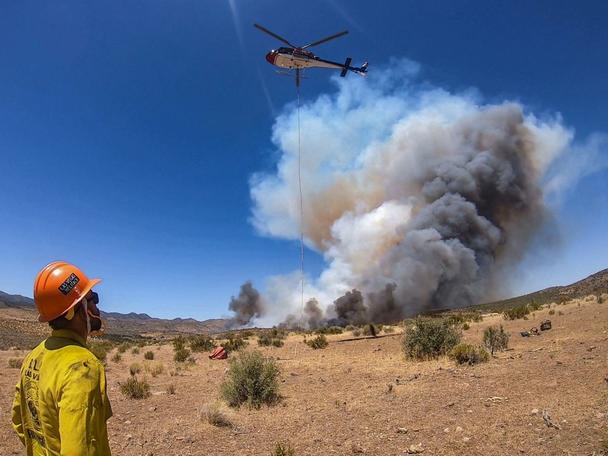Fighting Fires with the Helitack H125

“Helitack” – a blend of the words “helicopter” and “attack”, is a term coined in the 1950s to describe firefighting crews transported by helicopter to wildfires. The helicopter provides rapid and maneuverable transportation, allowing the helitack crews to quickly assess a wildfire situation and put in place the right plan of attack. We sat down with one such crew - Las Vegas Helitack (@lasvegashelitack) - to learn more about their incredible operations, the helicopter they use for rapid transport, and the amazing crew who risk their lives every day to serve their communities. Read the full interview below. Photos © Joe Bradshaw (@xcopperkidx)
Tell us your name, title, and who you’re working for.
Lucas Rhea, Las Vegas Helitack Supervisor (In the photo: 3rd from the left);
Joe Bradshaw, Las Vegas Helitack Crew member (In the photo: lying on the ground)

Which aircraft are you operating and which fires have you been fighting this 2020 season?
H125 and spent the season around the west, Big Summit, Meadow Valley, Badger, Elk, Bishop and multiple others.
What is the organization that you put into place during fire season to be ready to go at a moment’s notice when you get the call?
With a 12 person module we cover the helicopter 7 days per week. During duty hours we respond (skids up) to fire dispatches in less than 10 minutes.
How does the helicopter work to support the teams fighting fires on the ground? What operations are you carrying out with the helicopter (ie. Are you water bombing, or dropping retardant, or doing search & rescue, or scouting the blaze, or other, etc.?)
The helicopter is contracted to support Las Vegas Helitack responding to incidents (wildland fires) across the west but most extensively in the state of Nevada. We fly with standard initial attack (IA)load of 4 helitack firefighters and carry a complement of handtools (saw, scrapers etc) and a 180 gallon Bambi Bucket. When arriving on scene during IA we provide a "size up" of the fire and then deploy helitack to hook up the bucket and begin suppression operations. During the IA the helitack personnel begin digging line with hand tools while the helicopter drops buckets in support. As the fire evolves the crew and helicopter may be involved in any number of operations including: personnel transport, reconnaissance flights, cargo loads, ignition operations, emergency medivac etc. Our crew is also one of 4 Bureau of Land Management Helitack crews that uses STEP (Single skid, toe it hover entry/exit) techniques for fire suppression and emergency evacuation.
What are you looking for when selecting a helicopter for this mission (equipment, technologies, payload, performance, speed, rate of climb?)? What are the key factors for success?
Proven performance and accessibility. We have had an Astar for the past 11 years on contract and it is the perfect aircraft for helitack work in the Great Basin. We spend the majority of the summer at high elevations in extreme climate conditions and the H125 has been a proven workhorse. With all the different missions we are assigned its flexible cabin and external cargo basket has been extremely beneficial. The performance of the aircraft allows us to deliver 4 personnel plus gear and 700lbs of fuel on almost every IA we have.

What technical aspects of the H125 allow you to complete this crucial and oftentimes unpredictable and ever-changing mission? How do you stay safe and out of harm’s way?
The ability to change cabin configurations is key to our mission. In addition, the footprint of the aircraft allows us to perform missions in tight spaces in the basin. One of the biggest design advantages of the H125 is the skid placement. The position of the skids in relation to the cabin allows for external baskets that still allow ingress and egress.
What would you say to someone who sees the work that you are doing, be it the pilots or the firefighting team, and wants to one day follow in your footsteps? Any advice or suggestions for getting into this industry?
I’d say that the work we do, or what is visible to an external person, is the result of hard work, training and cohesion between our crew and our vendor pilots. To people who are interested in doing our job, all it takes is dedication - it’s amazing the leaps people can take by just applying desire. The keys to success and to overcome any barriers to entry is to reach out to people who have the jobs you are interested in. What did they do to get there? I personally know that getting to my current position would not have happened without well intentioned mentors to assist in my journey.
There are several upgrades that have been recently released and more to come for the H125 in the aerial work segment. What other upgrades would you like to see our company push forward?
The performance updates planned for the 2D engine can only help our crew’s operation. Between that upgrade and use of the BLR kits, the missions we accomplish with the aircraft will only grow, and the H125 will be an integral part of helicopter firefighting for years to come.

Could you share some H125 (or AStar) stories of how you were able to support a specific firefighting mission? It’d be great to be able to explain some of the shots from the Badger fire in September, for ex.
There are countless stories of when our helicopters have been the difference between a large fire and a small fire. The complete package of the H125 allows for rapid transition from deploying firefighters to support with bucket operations.